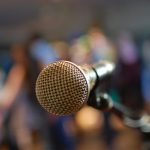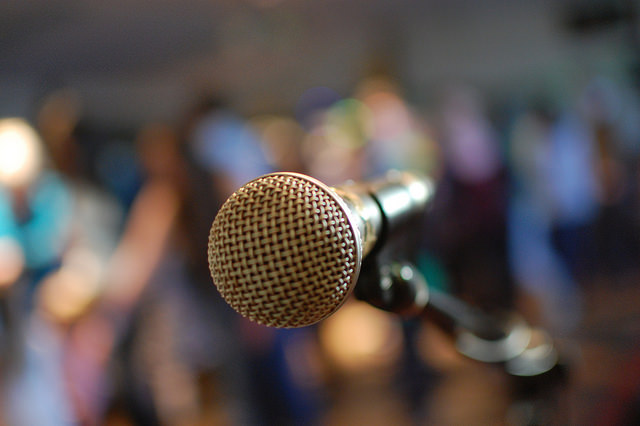
Image Credit: tie the ribbons
Not all speakers are equipped with a voice that could be heard in the back of a larger room. Back in the days before electricity, this was a big deal – only the very loud speakers had any chance of keeping the attention of an audience of any size and sharing the importance of public speaking. However, now with the invention of the microphone any speaker can be as loud as they want to be. However, if a speaker does not use a microphone correctly, then they are going to run into real problems. How should a speaker get the most out of a microphone?
Wireless Microphones
Anytime you are going to be delivering a speech using a microphone, you are going to want to make sure that you have a chance to check it out prior to your speech starting. The easiest way to do this is to show up early. Work with the people who set things up and make sure that the microphone system does not have any feedback.
If you are going to be using a wireless microphone as a part of your speech then you are going to be able to roam all over the stage and use your arms as a part of your speech. However, you’ll need to be careful if you speak softly or if the room is very large and can create feedback conditions. Since this microphone can’t be close to the mouth, it’s best if it is located in the center of your chest about 8 inches away from your mouth. Make sure that your clothes don’t either cover or brush against your wireless mic.
Hand-Held Microphones
Although we may not see them as much as we used to, a hand-held microphone is often a great choice for a speaker. The only real drawback to using this type of microphone is that it is going to fully occupy one of your hands during your speech. These types of microphones often provide the best sound quality of all types of microphones. Even the softest of speakers can get their voices amplified with very little risk of generating feedback.
The reason that this type of microphone works so well is because it can be held very close to the mouth. For those of us who have very loud voices or who are dealing with very loud sound systems, we can quiet things down a bit by holding the microphone further away from our faces. The best distance for this type of microphone is roughly one to four inches from your mouth.
Lectern Microphones
We are all probably quite familiar with lectern microphones. There are two basic varieties of these types of microphones: the long slender ones that you see on televised awards shows and the shorter fatter ones which are basically mounted hand-held microphones. The slender ones have a tendency to emit “pops” when your mouth is too close to them. Each one of these setups can have its own optimal distance between your mouth and the microphone. A good rule of thumb is between six and twelve inches.
When you are using a lectern microphone, you need to make sure that check the mic out for sound quality before your speech begins. Since these mics can extend over the lectern, you are going to want to make sure that they are not blocking your face from your audience. Additionally, you want to make sure that they won’t cover up any notes that you’ll be using during your speech. When you are using a lectern microphone, it is your responsibility as a speaker to remain in the same spot. If you turn your head away from the microphone, there is a good chance that your audience is not going to be able to hear you.
What All Of This Means For You
When you take the stage to deliver your speech, you have wonderful things to say and you want to share the benefits of public speaking. However, that’s not really going to do you a lot of good if nobody can hear you. That’s why knowing how to use a microphone is so important for speakers. However, there are a number of different types of microphones out there. How are we supposed to keep them all straight?
The most common type of microphone that we run into these days are the wireless microphones. These allow us to dance all over the stage and keep our hands free. However, we need to be careful to place them close enough to our mouths and to make sure that our clothing is not blocking them. The next most common type of microphone are the hand-held units. These will occupy one of our hands for the entire speech, but they give us the ability to get the microphone nice and close to our mouths. Finally, the lectern microphone is attached to the lectern and comes in two different varieties. We need to make sure that these units are not blocking our faces or our notes. Additionally, we have to make sure that we remain pointed towards them during our speech so that our audience can hear us.
Microphones have revolutionized the way that speeches are given. No longer does a speaker have to stand at the front of the room and scream his or her speech in order to be heard in the back of the room. We do need to treat these tools with respect and do some pre-speech checking in order to make sure that they will help our speech and not hinder it. Learn how to use microphones to your advantage and nobody in your next audience will be able to ignore your speech!
– Dr. Jim Anderson
Blue Elephant Consulting –
Your Source For Real World Public Speaking Skills™
Question For You: If you were given your choice of a wireless or a hand-held microphone, which one would you select and why?
![]() Click here to get automatic updates when The Accidental Communicator Blog is updated.
Click here to get automatic updates when The Accidental Communicator Blog is updated.
P.S.: Free subscriptions to The Accidental Communicator Newsletter are now available. Subscribe now: Click Here!
Note: What we talked about are advanced speaking skills. If you are just starting out I highly recommend joining Toastmasters in order to get the benefits of public speaking. Look for a Toastmasters club to join in your home town by visiting the web site www.Toastmasters.org. Toastmasters is dedicated to helping their members to understand the importance of public speaking by developing listening skills and getting presentation tips. Toastmasters is how I got started speaking and it can help you also!
What We’ll Be Talking About Next Time
Most speakers understand that if they can work a story or two into their next speech they’ll have a better chance of both capturing and holding onto their audience’s attention. What a lot of us don’t realize is that often times the stories that we are so good at telling all have a common theme that runs through them. If we can take the time to pick out what that theme is, we may have discovered a way to make ourselves become an even more powerful speaker and make better use of the importance of public speaking.

